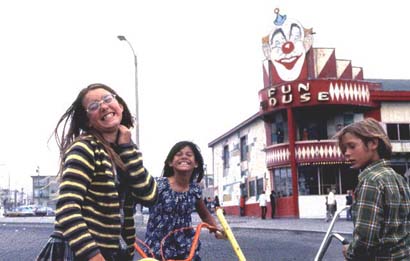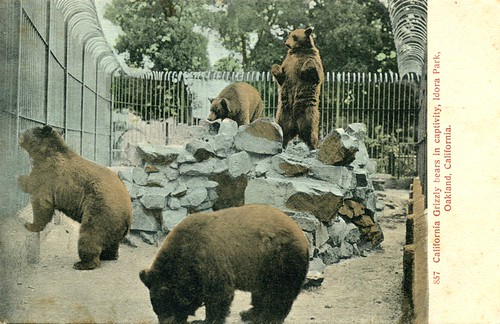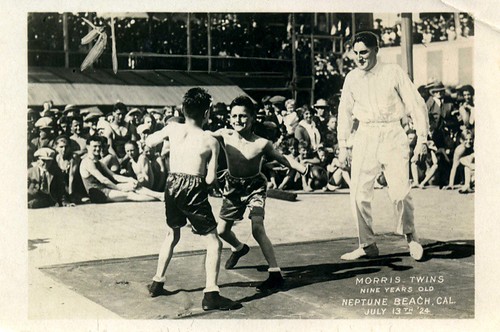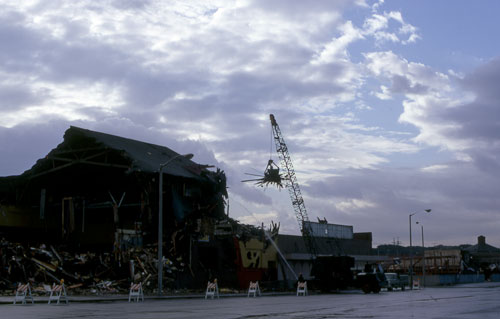Finals are over (thank the maker) and apparently, some guy named Jesus was born today. Seems like the right time to talk about boozing, gambling, and flipping upside-down on roller coasters. Here goes: Before TiVo, iPods, or Guitar Hero, when folks had to leave the house for a little something exciting, the Bay Area was peppered with amusement parks. The parks incorporated natural beauty along with human-made entertaiments like junk food, race-tracks and shooting ranges.
Playland at the Beach is the most well known of our lost parks. It started as a disorganized collection of concessions and rides at Ocean Beach in the late 1800s and only shut down in the early 1970s. At one point it spanned three city blocks and included roller coasters, merry-go-rounds, five restaurants, and eventually the Sutro Baths and the Cliff House restaurant which to this day traps tourists before they fall off the edge of San Francisco and onto Seal Rock in the Pacific. Outsidelands.org collects photos and stories of Playland and wikipedia has a pretty thorough entry including descriptions of the various rides nausea inducing rides like the Aeroplane Swing, the Whip, and Dodg-em.

Chelle and Noelle Beloy in front of the Fun House at Playland at the Beach.
Copyright Dennis O'Rorke, early 1970s from outsidelands.org.
From 1904 until 1929, Idora Park in the present day Oakland neighborhood of Temescal was home to a miniature railway, a car race track, the Illusion Theater, a successful opera house, and a skating rink that billed itself as the largest in the world. The park also housed a number of caged animal displays and served as a temporary home of the Oakland Oaks baseball team. This postcard set provides some images of that disappeared park.
Shellmound Park in Emeryville lasted from 1876 to 1924. It was built, morbidly, on the lopped off top of the Bay Area's largest indigenous Shellmound. The best online resource about the park is this PDF from the Emeryville Historical Society. You can read there about the pleasant picnic grounds, the shooting range, bowling alley, bicycle and horse racing and two dance pavilions that were part of this destination for San Franciscans who wanted panoramic Bay views and a getaway from city hustle. The picnic grounds in particular were utilized by all types of local civic groups, ranging from the Household of Ruth, a Black women's chapter of the Odd Fellows, to the notoriously racist Workingmen's Party. Local anti-gambling ordinances and the new national alcohol prohibition killed Shellmound Park. There's no point in picnics and horse races without booze, apparently.
Neptune Beach didn't open until 1917, late compared to other Bay Area parks, and it lasted until 1939 when the depression and increasing car use spurred in part by the recently completed San Francisco Bay Bridge made Alameda a less appealing destination for Bay Area funseekers. While it lasted it contained a giant swimming area, prime beach land, snacks, concessions, and a roller coaster that offered views across the Bay to San Francisco.
Amusement parks were popular around the country in the early 20th century. Most started as Trolley Parks, created by the streetcar companies as a destination for trolley lines. The parks were often built at beaches or, as in Idora Park, at locations that otherwise showed off nature's lovelier features. The natural features were eventually obscured by the gaudy rides that were installed later. The parks patterned themselves after each other and tended to rip off rides and even their names from larger or more successful parks elsewhere in the country. You might recognize the name "Playland" for example from the more famous Long Island park of the same name. Like the streetcar companies that built these places, the parks themselves were killed by the rise of car culture – not to mention the Great Depression and then television. Although as in the case of Playland, there were some late holdouts. Amusement Park fans are quite loyal. Besides lovingly maintained memorial websites to the various amusement parks, the Neptune Beach Amusement Museum is trying to build a physical space in the old location of Neptune Beach.
(Thanks so much to peacay at the beautiful bibliodyssey for giving me the Cliff House link that started me on this post.)






1 comment:
It was certainly interesting for me to read that post. Thanks for it. I like such topics and anything connected to this matter. I would like to read more soon.
Post a Comment